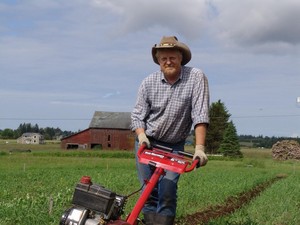11 Jun Thu 2009
When Meat Becomes a Treat
People may have noticed how cheap red meat, pork and poultry is right now in the Pacific Northwest. Meat may also be cheap in your part of the country. There may be overriding political concerns that encourage dumping to keep the populace well fed (sort of like an American version of bread and circuses - in this case hamburgers and trash TV). It may just be that corporations make SO much money that they can afford to lower their prices dramatically and still make a profit. Another reason is that since feed prices are still high (controlled by corporations of course), costs of production continue to be well above commodity prices paid to the farmer. Since there is already plenty of meat in supermarket cases, increasing production (the old "get big or get out") will not necessarily provide a living, especially if there is no profit margin anymore due to high feed costs.
A contributing factor in the case of beef is the CWT Dairy Herd Reduction Program. CWT stands for Cooperatives Working Together and has been around since 2003. The program is funded by a 10 cent contribution per producer or cooperative on each hundredweight of milk sold. The idea is to retire dairy cows and heifers to reduce the volume of milk produced in this country, thereby increasing the price paid to the farmer. As an example, the price of Class III milk (milk used to make butter, cheese and nonfat dry milk) was down to $9.84 per hundredweight in May and has risen to $9.95 in June. The futures price is expected to rise to $14.30 per hundredweight in December. For those unfamiliar with milk pricing in hundredweights, milk weighs 8.5 pounds per gallon, so at $9.95 per hundredweight (cwt.) a gallon of milk sold for making cheese is now valued at 85 cents. The futures price in December values a comparable gallon at $1.22 - an increase of 44% over the current price! The reason for this dramatic rise is probably due to many factors, but the success of the CWT Herd Retirement Program seems significant.
CWT has conducted six herd retirements since 2003, removing 276,000 cows. The most recent was in February and removed 51,000 cows. The latest audit of participating farmers started May 20th and CWT plans to retire 103,000 cows in this go-round. This will remove about 2 billion pounds of milk per year. The upshot here is that not only is CWT increasing the number of cows removed per round, but is also stepping up the frequency of removals. Of course the Beef Associations around the country are worried, but there is really nothing they can do about it because the program is privately funded by dairymen themselves.
Even though CWT Herd Reduction Programs are having a big impact on milk prices, it does not have a causal effect on the glut of pork and poultry in the supermarkets. The major problem overall still seems to be the high cost of feed. Animal feed is subject to the same middleman effect to which human food is subject. In other words, that bag of chicken feed you buy for your layers has a very low commodity cost paid to the farmer, but a lot of money made by the middleman before you pick it up at neighborhood feed & seed store. So . . . farmers are culling their flocks and herds and the resulting glut of meat makes the prices cheap. However, culling can be done quickly, but building your herd or flock back up once the prices rise takes much more time.
I suspect the futures price of milk in December correlates well with a significant rise in all animal product prices by Christmas-time, simply because the feed grain prices show no signs of coming down (high petrol prices for production and transportation, impacts of ethanol production, export sales, etc.). If you have a freezer, you might want to stock up now. Otherwise, rethinking your lifestyle and dietary habits is appropriate. The upside to decreased meat consumption is less methanol in the atmosphere and a generally higher level of health in the general populace, so it won't be a bad thing when meat becomes a treat.

